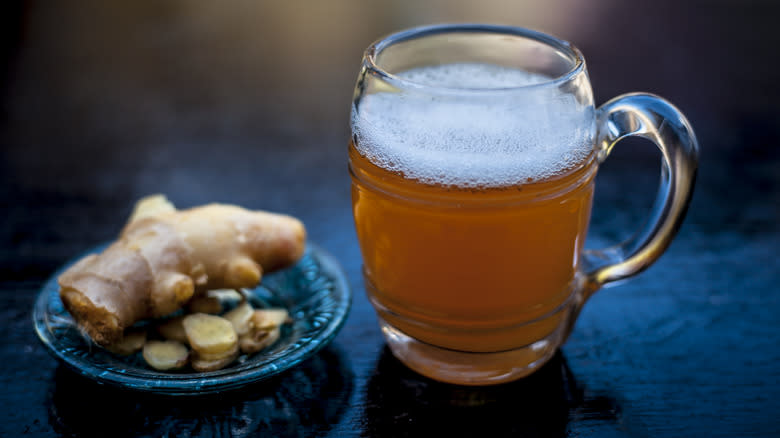North Americans Love Ginger Beer, But It Originated Across The Pond

It's not surprising that North Americans love ginger beer. It's a wonderfully spicy addition to the drink quiver, and it makes up the better part of popular alcoholic beverages like the Dark and Stormy and the Moscow Mule. Unlike its sweeter cousin, ginger ale, this beverage is usually brewed from ginger root and has a more powerful spicy flavor. North Americans consume more ginger beer than those on any other continent (per Future Market Insights), but they can't lay claim to the beverage's origin. Those rights go to the British.
The consumption of ginger beer is generally believed to date back to 18th-century England. The English were in a good position to produce the beverage since the flavor of ginger beer and its fermentation relied on ginger and sugar, and the country had plenty of it. Due to European colonialism of the Caribbean, England had been importing sugar and millions of pounds of ginger farmed by people kept as slaves in Jamaica since the mid-1500s. By the time the 1700s rolled around, this once-exotic spice was more commonplace. Since the English were also armed with centuries of mead and beer brewing knowledge, creating ginger beer was a cinch.
Read more: Diet Sodas, Ranked Worst To Best
The Earliest Ginger Beers

People had been adding ginger to different mead and ale concoctions pretty much since ginger arrived in the British Isles, likely for medicinal reasons or to spice up the beverages with new flavors. These weren't true ginger beers, but they probably evolved into them. The first true ginger beers came later, when the unique process of fermenting ginger with yeast and bacteria was stumbled upon, though the specific origins of the discovery are somewhat murky.
We do know, however, that these early ginger beers contained a low alcohol content due to the fermentation process, similar to the "small beers" the British had been drinking since the Middle Ages in place of unclean drinking water. These small beers were often brewed at home from spent mash that had already been used to brew more powerful beers. Ginger beer was likely brewed at home in a similar fashion, and because of its low alcohol content, it would've provided the same hydrating benefits as small beers. Ginger beer contained the added bonus of the spice's medicinal qualities.
Ginger beer grew in popularity across England, eventually being mass-produced in stoneware bottles. The sturdy thickness of these bottles allowed them to be shipped across the Atlantic to a growing North American market as colonization settled in. The love of ginger beer followed the colonists to the Americas, where it would grow into the biggest market for the beverage in the world a few centuries later.
Read the original article on Mashed.
